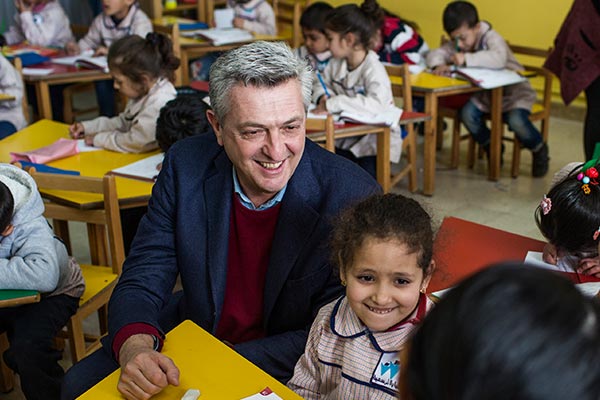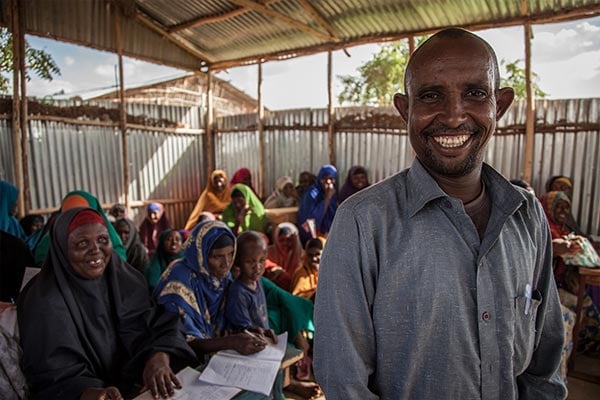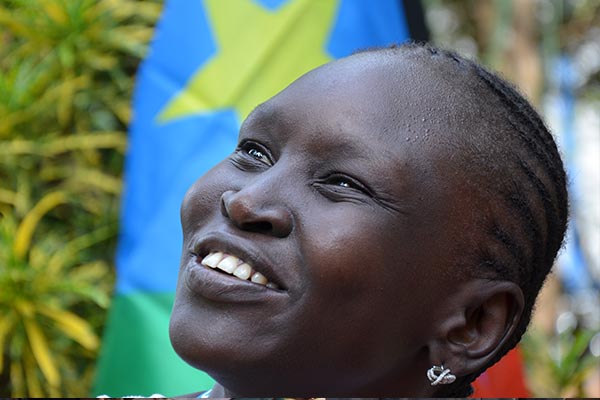Chapter 1:
Education in emergencies
Sala, 6, Nigerian refugee in Niger attends school together with local children. © UNHCR/Helene Caux
Away from the chaos, safe spaces for refugee children
For children who were forced to flee their homes, education provides stability and security when everything else in their lives seems to have fallen apart. As signatories to the New York Declaration for Refugees and Migrants declared, “access to quality education, including for host communities, gives fundamental protection to children and youth in displacement contexts, particularly in situations of conflict and crisis.”
For many refugee children, a classroom can be the first peaceful and reliable environment they encounter. While their parents are trying to cope with the reality of displacement – seeking food and shelter, making contact with aid agencies and the relevant government organizations – children can find a place of safety in school, meet their peers and start or resume structured learning.
Equally important are the life-saving skills and information they gain – such as how to avoid danger, how to prevent disease and where to find help. Furthermore, schools with trained teachers and support staff are able to help address the psychological and social needs of young children and adolescents recovering from the trauma of conflict. As such, education is a core part of UNHCR’s emergency response to a humanitarian crisis.
Education in an emergency situation does not mean “emergency education” – that is, temporary measures that accidentally turn into long-term responses to children’s educational needs. Children and adolescents have the right to an education that will ensure they meet their potential; a system with no recognized examinations or certification, with inadequate materials and poor infrastructure, taught by under-trained and under-qualified teachers, will in no way provide this. Consequently, education needs to be woven into planning and funding for refugee emergencies, at national and international levels, and systematically included in national development and education sector planning and budgeting.
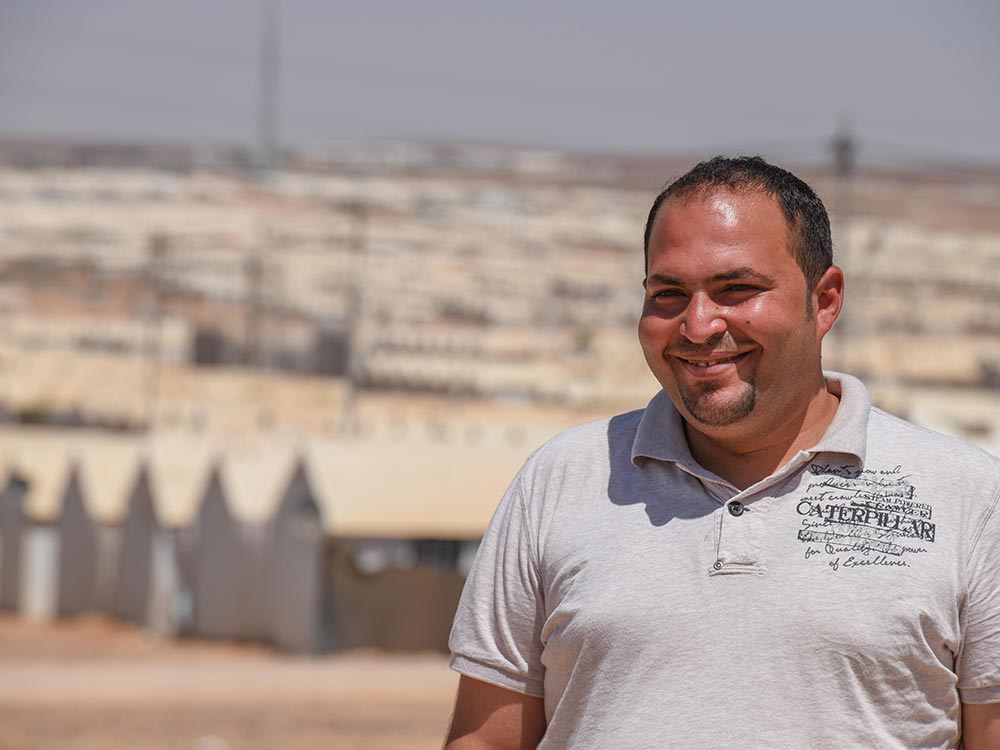
© UNHCR/Mohammad Hawari
“Studying with top universities and being connected to the outside world of academia makes you feel part of something bigger – not just a number in a refugee camp.”
Qusai, 27, Syrian refugee living in Azraq refugee camp, Jordan
Making up for lost time
Refugee children may have missed out on months or years of education before fleeing their countries. To help them bridge the gap of many missed years of schooling, more flexible forms of education are essential such as accelerated education, catch-up and bridging programmes.
Accelerated education comprises a condensed curriculum so that students can complete it in half the number of years normally required for that level, or even less. Students sit for accredited examinations which allow them to be integrated into mainstream education (in the right class for their age), transfer to the next level or move on to skills-based technical and vocational education. Catch-up and bridging programmes either help students learn content they missed or give them the knowledge and skills (such as the acquisition of a new language) they need to adapt to a different system.
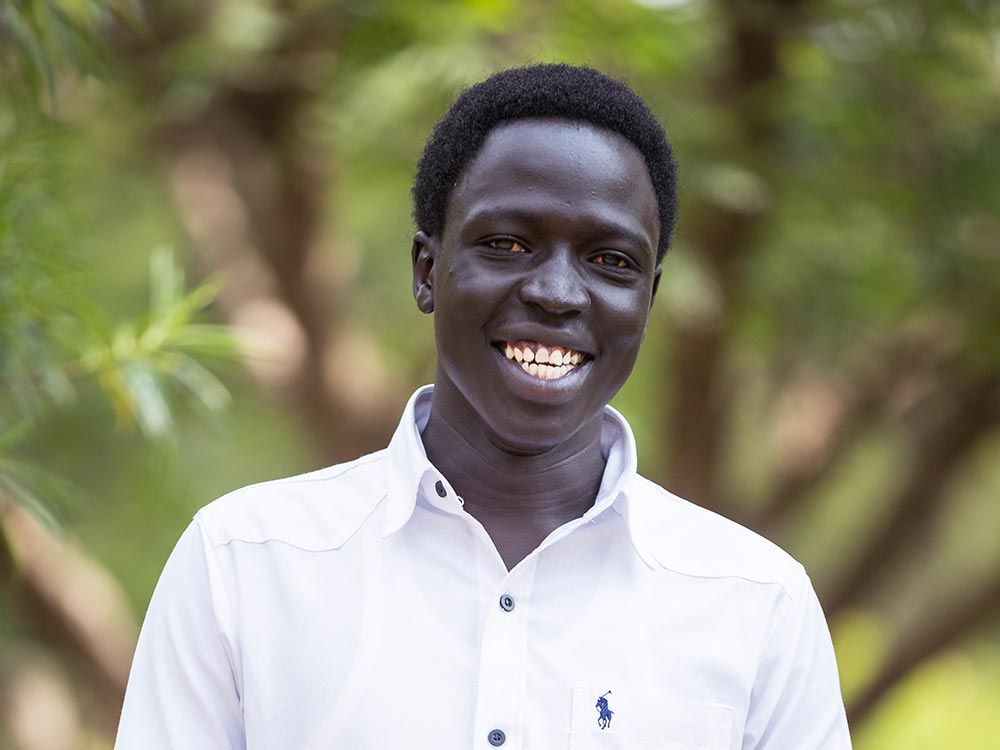
© UNHCR/Antoine Tardy
“I can see a bright future for myself once I am done with my studies. I will go back to South Sudan and I will help my people, through whichever means, except guns. I don’t know how I will contribute yet but I will. I must.”
Samuel Mabil Deng, 26, Kakuma refugee camp, Kenya.
A response to emergencies that needs sustained support
Signatories to the New York Declaration undertook “to provide quality primary and secondary education in safe learning environments for all refugee children, and to do so within a few months of the initial displacement.” These last few words are crucial, recognizing as they do the protective benefits of education, especially in the early phases of an emergency, and a commitment to every child’s right to education.
Education cannot be allowed to fall victim to the ebb and flow of funding when new conflicts blow up and fresh emergencies need addressing. It is deeply unfair to provide schooling for a child for one year only to take it away the next because they are no longer considered “part of an emergency.” The goal of an inclusive education requires a long-term commitment from the international community. It also requires contingency planning and preparedness by host governments, development actors and humanitarian agencies.
Refugee children deserve an education of quality that will last them a lifetime. Education must be an integral part of our response to emergencies, not an afterthought that falls gradually into neglect.
Case study
Nyahok’s Quest
Nyahok Reath, 16, South Sudanese refugee living in Kule refugee camp in Gambella, Ethiopia. © UNHCR/Clementine Malpas
Nyahok was a star student at her primary school and had her heart set on becoming a pilot. But her route to secondary school is barred and her lifelong ambition remains out of reach.
Before she and her family fled their home in Nasser, in South Sudan’s Upper Nile State, Nyahok would watch, enthralled, as United Nations aircraft carrying aid supplies flew in and out of the nearby airport. “My dream has always been to be a pilot,” she says. “When I was young, I saw a lot planes flying around Nasser. I saw the pilots when they got out of the planes and their fancy uniforms. I want to see every country.”
Star student still hopes for a place at secondary school
Now a resident of the Kule refugee camp in Gambella, Ethiopia, Nyahok, 16, knows that moving through secondary school is the only way to turn her dream into reality. But there is only limited provision for the first year of secondary school in the region; after that, hardly any refugee adolescents have a classroom to go to. The region is one of the least developed and remote states in Ethiopia – and more refugees are arriving all the time.
For Nyahok, hope briefly appeared in the form of her uncle, who lives in Kenya and who offered to pay her secondary school fees. With her parents’ full support, she left the camp and set off to Nairobi to pursue her studies. After only six months, however, her uncle ran out of money. “It soon became hard for him and he couldn’t pay the school fees anymore,” she says, staring at her feet as she sits on her bed, chatting with her father, Reath Kun.
Pressure on education system constantly growing
The South Sudan crisis has created the fastest-growing refugee population in the world. Of the more than 2 million people who have fled South Sudan, 62 per cent are under the age of 18. The Ethiopian government has stated its intent to improve educational access at all levels for refugees and for its own people, but it is under significant pressure. Only 9 per cent of secondary school-age refugee children in Ethiopia have a place in a classroom, well below the 23 per cent rate for refugees globally and light years away from the 84 per cent figure for their non-refugee peers.
That means that youngsters such as Nyahok simply run out of opportunities. “I did not have the chance to go to school,” says her father. “Nyahok, I want her to go to school. I am very proud of her, for her achievements in school and for her drive.”
Despite her setback, Nyahok still has her eyes on the skies. “It would make me very sad if my dream of becoming a pilot would not come true.” That, she says, is how she can explore the world and take care of her family at the same time.
“I would leave again if I had to, to get my education.”

